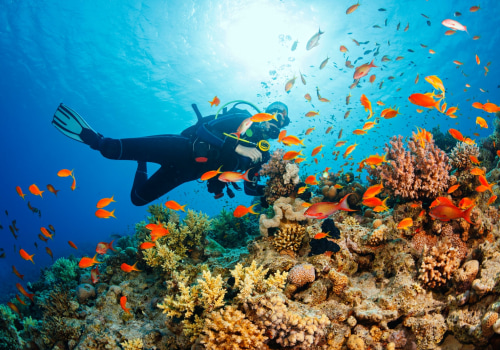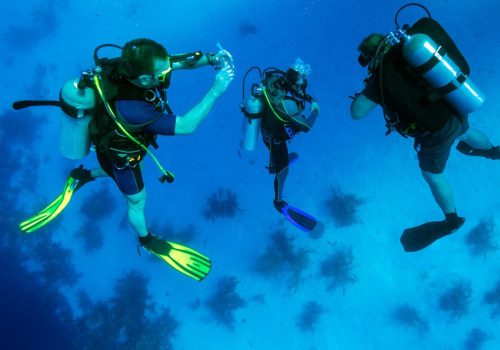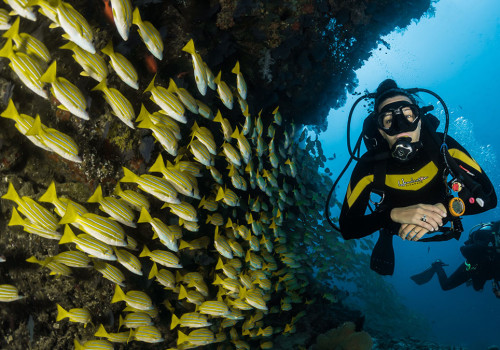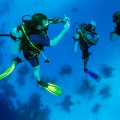Underwater photography and videography can be a tricky business, especially when it comes to night-diving or deep-diving with a light source. The first and most traditional way for wide-angle underwater cameramen to add colors that have been lost due to light attenuation is to manually balance white with their video camera. This is done by bringing in a neutral white or gray board and telling the camera what deep white is. However, manual white balance isn't very accurate, as it depends on the camera's internal color science (unless you're shooting RAW video).Manual white balance is rarely a good method once you're below 40-50 fSW, except with the most advanced cameras.
The second way to bring colors back to your video is to add deep white light, yourself with an underwater video light. Often, this will produce much more vibrant colors in the video, but only when you illuminate the subject with light. You also need to balance the power of the video light with the ambient light, so you'll need much more artificial light in clear, shallow water. In the past, this made manual white balance the ideal choice for capturing video in shallow water (30 feet or less) and video lights were a better option at deeper depths. However, with wide-angle, high-power video lights, such as those of the Kraken 8000, the Sola 15000 and the Kraken Solar Flare Mini, it is possible to capture excellent wide-angle videos at a shallow depth and keep the scenes vibrant thanks to video lights.
The most important thing to understand about lumens is that they are more a measure of power than brightness. Lumens are the total amount of visible light emitted by a light source during a unit of time. The beam angle can dramatically affect the area covered by the light and, therefore, lumens are not a good measure of brightness. That said, they can be a rough estimate of brightness if you're trying to figure out what light will work best for a given use case. This is the most common question we receive from first-time video recording.
As I mentioned before, it can be difficult to answer, but lumens can be a rough guide to the type of video you can shoot with a light (just like the guide numbers for strobe lights don't tell you anything, but you can estimate what kind of photos you can take with them). A video light of 8,000 to 15,000 lumens is an excellent choice for professional video systems and low-depth wide-angle video. Of course, they can also be used for macro videos, but their real advantage is when shooting in the sun and fighting against a lot of ambient light. These video lights are also powerful enough to take still pictures, which means you're not limited by the sync speeds of the strobe lights. However, keep in mind that fish are often startled by continuous high-power lights. The color indicates how warm (red) or cold (blue) the light source is.
Cooler lights have a higher color temperature in degrees Kelvin and vice versa for warm lights. There's no right or wrong color temperature for a light; it all depends on how you want to balance the artificial foreground light with the ambient light. The beam angle can make a big difference when it comes to light quality. A beam angle measures the angle of coverage of the beam from the light. A wider beam angle means the light covers more area.
Lights with a wider beam angle tend to have a softer light than lights with shallower beam angles. Most lights will range between 90 and 120 degrees. A beam angle of 90 degrees is good for macro video. Lights with 90-degree beams tend to be rougher, making them ideal for creating contrast. Generally, you'll want two lights if you're shooting a video with a very wide angle.
You may be able to take wide-angle photos with a 100-degree light, but you'll want to spend some time placing the light if you only have one to make sure there isn't too much shade. These lights are ideal for wide-angle videos. With a 120-degree video light, you may be able to capture wide-angle video with a single light. A spot beam is a narrow, usually white beam that isn't wide enough to record video underwater. It is ideal for signaling your diving partner or for using it as a focus light for photographs.
A flood beam is a beam that is wide enough to record videos underwater. A red beam is ideal for sneaking up on underwater creatures that can't see red light. It is especially useful as a focusing light if it has an automatic shutdown function activated by the flash. RGB LEDs can be combined to form almost any color.
You can use an RGB beam for creative photos or videos, but they can be a bit misleading and overused. Night divers are advised to have a primary and secondary divelight for safety reasons. For maximum visibility in nighttime waters, select a light with a wide, bright beam that penetrates the dark. When it comes to diving lights, the general rule is that the brighter, the better. This is particularly true in night diving, when a bright light emission with a wide beam, such as the Light Cannon or the Aqualite, is recommended for maximum visibility. Using video dive lights in any of the situations we've mentioned can help divers capture the subject.
The primary purpose of a secondary or backup dive light is to protect the diver during a night dive in case the main dive light fails. The best prices, service & Expert tips for booking your diving trips Bluewater Travel is your full-service dive travel agency. Let our expert advisors plan and book your next diving vacation.








